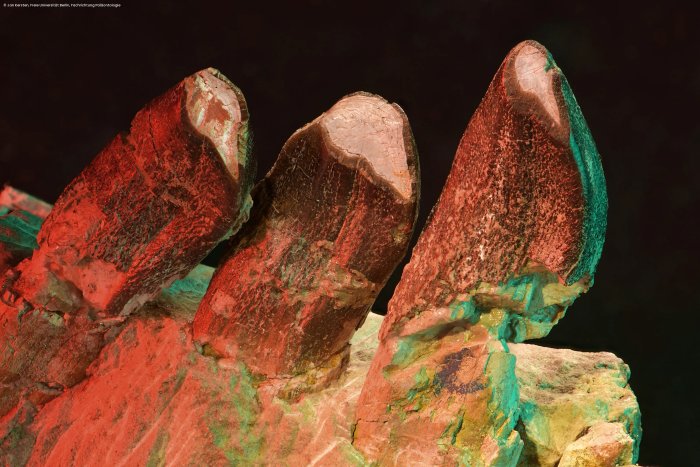Eddie Gonzales Jr. – AncientPages.com – What did long-necked dinosaurs eat – and where did they roam to satisfy their hunger?
How did massive dinosaurs live during the Jurassic period? How did they share habitats, and did they migrate seasonally?

Photo of teeth in a jaw section of Giraffatitan from Tanzania (Museum für Naturkunde Berlin, MB.R.2180.20.5). The light-coloured area is the dentin, which has been exposed by tooth wear. Image credit: Jan Kersten – source
An international research team included Daniela E. Winkler, a postdoctoral researcher at Kiel University, Dr Emanuel Tschopp, visiting scientist at the LIB and research associate at Freie Universität Berlin, and André Saleiro, PhD student at NOVA University Lisbon.
The team reconstructed the feeding behaviour of sauropods using cutting-edge dental wear analysis. Their findings show that microscopic enamel wear marks provide surprising insights into migration, environmental conditions, and niche distribution within ecosystems from 150 million years ago.
Their new study employs an unusual method: using wear marks on fossilised teeth as a window into the past.
“I find it fascinating that microscopic scratches on fossil teeth reveal so much about diet and behavior,” says Winkler, an expert in the methodology. Dental Microwear Texture Analysis (DMTA), initially developed by Professor Thomas Kaiser’s group for studying mammals, is now applied to sauropods in a study published in Nature Ecology and Evolution. The analyses were conducted at LIB laboratories.
Tooth Enamel as an Environmental Archive
The team analyzed 322 high-resolution 3D scans of tooth surfaces from three well-known dinosaur fossil sites: Lourinhã Formation in Portugal, Morrison Formation in the USA, and Tendaguru Formation in Tanzania. The teeth belonged to 39 individuals and samples were taken from original teeth or high-resolution silicone molds.
“We’re talking about structures at the micrometre scale,” Winkler explains. “These tiny wear marks results from the interaction between tooth and food – they reveal what the animals had eaten in the last days or weeks of their lives.”
Surprising Differences between Species and Regions
Statistical analyses showed clear differences among sauropod groups and their geographic regions. Notably, the flagellicaudatans, including Diplodocus, exhibited high variability in wear patterns. This suggests they had diverse food sources and generalist feeding behavior.

Original skull of the Giraffatitan from Tanzania (Museum für Naturkunde Berlin, MB.R.2223). Image source
Surprisingly, Camarasaurus specimens from Portugal and the USA had uniform wear patterns. This consistency suggests these dinosaurs deliberately sought the same preferred food sources year-round, rather than relying solely on uniform plant availability.
“The climate at the time in both Portugal and the USA was highly seasonal, so certain plants likely weren’t available year-round,” explains Emanuel Tschopp. “The consistency in Camarasaurus tooth wear suggests they may have migrated seasonally to access the same resources.”
Titanosauriforms from Tanzania had teeth with intense, complex wear due to specific environmental conditions. The Tendaguru Formation’s tropical to semi-arid climate and nearby desert likely blew quartz sand onto plants these sauropods ate, causing abrasive tooth wear.
Climate, Not Plant Variety, as the Key Factor
There were also clear differences between the regions themselves: teeth from Tanzania were consistently more heavily worn than those from Portugal or the USA. The crucial influencing factor? Climate.
“One of the most interesting aspects of this work is that we were able to relate differences in dental wear patterns to palaeogeography and the habitat preferences of different sauropod faunas,” concludes André Saleiro. These findings also guide his future research: “The study showed me how to approach my ongoing work on niche partitioning in herbivorous dinosaurs – by focusing on specific palaeo-environments to better understand the ecological relationships within species groups, and how these differences evolved across ecosystems.”
For Emanuel Tschopp, this is also one of the most exciting elements of the research: “With these microscopic traces, we can suddenly make behavioural statements about these enormous extinct animals. Migration, specialisation, niche use – it all becomes tangible.” Another notable aspect: wear patterns differed depending on the area of the tooth – on the side (buccal) or on the chewing surface (occlusal). These differences were accounted for in the analysis to avoid distortion.
Relevance for Biodiversity Research
This study provides not only new insights into the lives of individual dinosaur species but also contributes to a broader understanding of palaeoecological relationships. Niche partitioning, climate-driven adaptations, and potential competition avoidance can thus be identified even in fossilised ecosystems.
“We demonstrate that ecological principles like niche formation and migration behaviour were important not just today, but already 150 million years ago,” says Winkler. Tschopp adds: “The sauropods of the Morrison Formation show enormous species diversity – and that diversity was only possible because the species behaved differently and occupied different dietary niches.”
Looking Ahead: More Teeth, More Knowledge
The research is ongoing. Future studies will explore dietary differences between juvenile and adult sauropods and how dwarf species like Europasaurus adapted to island environments. Saleiro is expanding the dataset for Portuguese fauna, including other herbivorous dinosaurs.
Winkler expresses enthusiasm about the continuous refinement of this method, noting that each new sample contributes an additional piece to the puzzle.
“Our tools are improving, as is our comprehension of what life was truly like in those times.” Tschopp concurs with this perspective, observing that while they are still in the early stages of utilizing this method, the integration of paleontology with modern technology and interdisciplinary collaboration offers captivating insights into ancient worlds.
Source
Paper
Written by Eddie Gonzales Jr. – AncientPages.com – MessageToEagle.com Staff Writer









